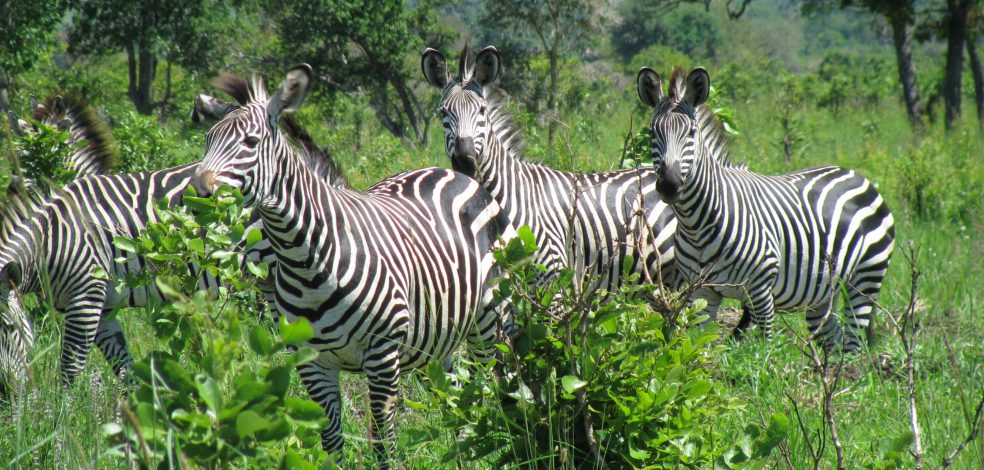Christopher Columbus’s journal describes how his ships had to plow through masses of sea turtles to reach the shore of Caribbean Islands. Since the 15th century, populations of the green turtle (Chelonia mydas) were nearly extirpated, primarily to feed the expanding human population. Recent conservation programs have led to a partial recovery in the Caribbean, but current green turtle populations are still a small fraction of what they were historically.

While the green turtle recovery is good news for turtles, it’s not clear how their favorite food in the Caribbean, the seagrass Thalassia testudinum feels about green turtle resurgence. When green turtle populations were at their lowest, many lush seagrass meadows performed ecosystem services such as sequestering carbon via photosynthesis, stabilizing marine sediment and providing important nursery habitats for commercial fisheries.
Alexandra Gulick and her colleagues were inspired by a similar situation that has been occurring in terrestrial ecosystems. Since around 1960, wildebeest and buffalo populations in the Serengeti have increased sharply – a result of the sharp decline (or possible elimination) of the rinderpest virus, which previously had controlled the abundance of those two large mammals. The increase in buffalo and wildebeest populations has profoundly affected the distribution, abundance and productivity of grasses and trees, which of course impacts the entire ecosystem. Gulick wondered whether the return of green turtles was an analogous situation, in which increases in green turtles would dramatically reduce seagrass meadows and alter ecosystem functioning.

Gulick and her colleagues were looking for evidence of compensatory growth – increased seagrass growth in response to grazing. Green turtles use a cultivation grazing strategy, in which they select and repeatedly crop the same meadows. Such behavior would make sense if grazed meadows compensated for grazing by producing biomass at a higher rate, or by producing leaves that were more digestible or nutritious.

Working at the Buck Island Reef National Monument, off St. Croix, Virgin Islands, the researchers studied both grazed and ungrazed seagrass meadows, in both shallow water (3-4 meters) and deeper water (9-10 meters). They placed 129 turtle-proof exclosures over grazed and ungrazed meadows during August-October 2017 and January-February 2018. After 7-10 days they measured how much growth had occurred in both types of meadows.

The data table below shows some good evidence for compensatory growth in grazed meadows, particularly in shallow water, but also in some of the deep water meadows. Grass blades grew longer and achieved greater surface area in grazed meadows in shallow water, and also in deep water during the winter (their growth rate was slightly greater during the summer as well, but this increase was not statistically significant). However, the seagrass in grazed meadows added much less biomass (dried weight) per day per m2.

How can a seagrass blade have more surface area but less biomass? There are at least two answers to this question. First, seagrass biomass was measured on a per m2 basis, and ungrazed meadows had more blades per m2. Second, while achieving greater surface area, the seagrass blades from grazed meadows were much thinner, so when dried they weighed much less. This is important, because putting their resources into surface area allows the seagrass blades to achieve a high photosynthetic rate, which should allow them to recover relatively quickly from sea turtle grazing. The bottom row in the data table above is a measure of production (measured as mass growth) in relation to initial biomass (P:B). You can see that P:B in deep water is similar in grazed vs, ungrazed meadows, while P:B in shallow meadows is substantially greater in grazed meadows. This indicates that despite continuous cropping by sea turtles, the grazed seagrass can recover quite nicely.
Gulick and her colleagues wanted to know whether the intensity of grazing might affect productivity. They counted the number of grazed vs. ungrazed shoots, and the length of grazed vs. ungrazed blades for each sample site, and used those data to calculate grazing intensity. The researchers then generated a model that calculated P:B in relation to grazing intensity. The model shows that high grazing intensity increased P:B, indicating that grazing is stimulating increased leaf tissue production.

These findings indicate that increased grazing intensity by recovering sea turtle populations is sustainable in Caribbean seagrass meadows, as seagrass growth was still stimulated at relatively high grazing intensities. Many of the meadows had been grazed continuously for at least two years, and still showed no evidence of being overly stressed by the attention that turtles had given them. Presumably, compensatory growth by seagrass is an adaptation resulting from the co-evolution of seagrass with green turtles and other hungry herbivores. In support of this coevolution scenario, seagrass in grazed areas reduces the height of its flowers and fruits, reducing consumption of these structures by green turtles, and allowing it to achieve reproductive success. As green turtle populations continue to recover, it is likely that seagrass meadows will be grazed more heavily, but, at least in most cases, will be able to successfully compensate for even greater grazing levels.
note: the paper that describes this research is from the journal Ecology. The reference is Gulick, A. G., Johnson, R. A., Pollock, C. G., Hillis‐Starr, Z., Bolten, A. B., and Bjorndal, K. A.. 2020. Recovery of a large herbivore changes regulation of seagrass productivity in a naturally grazed Caribbean ecosystem. Ecology 101( 12):e03180. 10.1002/ecy.3180. Thanks to the Ecological Society of America for allowing me to use figures from the paper. Copyright © 2020 by the Ecological Society of America. All rights reserved.





